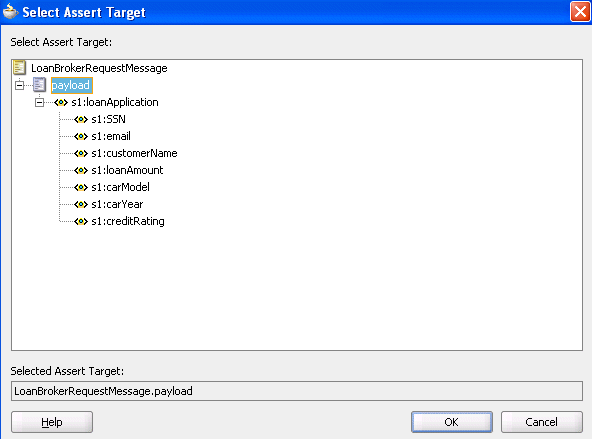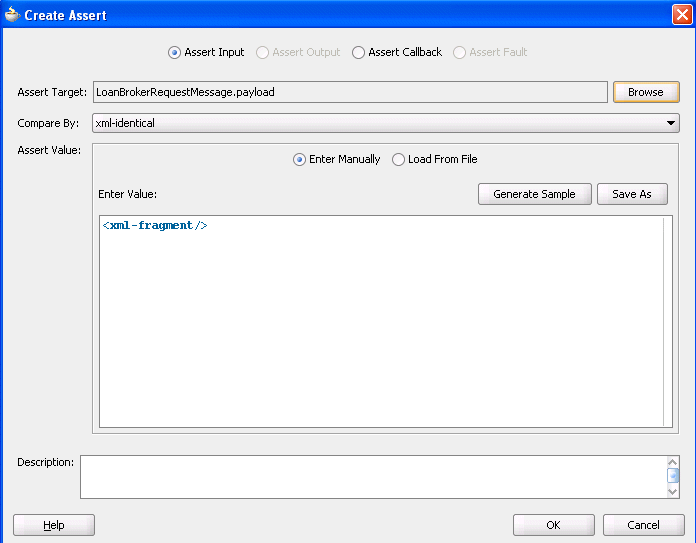- Developing SOA Applications with Oracle SOA Suite
- Completing Your Application
- Automating Testing of SOA Composite Applications
- Editing the Contents of Test Cases in Test Mode in the SOA Composite Editor
- How to Create Assertions
- Creating Assertions on a Part Section, Nonleaf Element, or Entire XML Document
Creating Assertions on a Part Section, Nonleaf Element, or Entire XML Document
To create assertions on a part section, nonleaf element, or entire XML document:
This test compares the values to the expected values.
Note:
If the message contains multiple parts (for example, payload1, payload2, and payload3), you must create separate assertions for each part.
- Click Browse to select the target part section, nonleaf element, or entire XML document to assert.
The Select Assert Target dialog appears.
- Select a value, and click OK. For example, select a variable such as payload to perform a part section assertion.
Figure 51-17 shows this dialog. While this example shows how to perform a part section assertion, selecting LoanBrokerRequestMessage is an example of an entire XML document assertion and selecting loanApplication is an example of a nonleaf assertion.
Figure 51-17 Select a Part Section of a Message

Description of "Figure 51-17 Select a Part Section of a Message"The Create Assert dialog refreshes based on your selection of a variable.
- Enter details in the remaining fields, as shown in Table 51-12:
Table 51-12 Create Assert Dialog Fields and Values
Field Value Fault
Select the type of fault to assert (for example, NegativeCredit). This field only displays if you select Assert Fault in Step 4.of How to Create Assertions.
Assert Target
Displays the assert target you selected in Step 2.
Compare By
Specify the strictness of the comparison.
-
xml-identical: Used when the comparison between the elements and attributes of the XML documents must be exact. If there is any difference between the two XML documents, the comparison fails. For example, the comparison fails if one document uses an element name of
purchaseOrder, while the other uses an element name ofinvoice. The comparison also fails if the child attributes of two elements are the same, but the attributes are ordered differently in each element. -
xml-similar: Used when the comparison must be similar in content, but does not need to exactly match. For example, the comparison succeeds if both use the same namespace URI, but have different namespace prefixes. The comparison also succeeds if both contain the same element with the same child attributes, but the attributes are ordered differently in each element.
In both of these examples, the differences are considered recoverable, and therefore similar.
For more information about comparing the contents of XML files, see the XMLUnit web site:
http://xmlunit.sourceforge.net/userguide/html/ar01s03.html#The%20Difference%20EnginePart
Select the message part containing the XML document (for example, payload).
Value
Create an XML document whose content is compared to the assert target content:
-
Enter Manually
Click to manually enter message data in the Enter Value field. A Generate Sample button enables you to automatically generate a sample file for testing. Click Save As to save the sample file.
-
Load From File
Click the Browse icon to load message data from a file. The file is added to the messages folder in the Applications window.
Description
Enter an optional description.
Figure 51-18 shows this dialog with Assert Input selected:
Figure 51-18 Create Assert Dialog with Assert Input Selected

Description of "Figure 51-18 Create Assert Dialog with Assert Input Selected" -
- Click OK.
The Wire Actions dialog shown in Figure 51-19 displays your selection.
Figure 51-19 Wire Actions Dialog with Asserts Tab Selected

Description of "Figure 51-19 Wire Actions Dialog with Asserts Tab Selected" - Click OK.